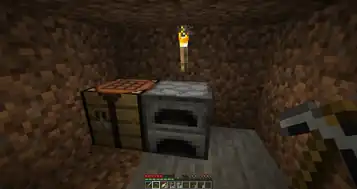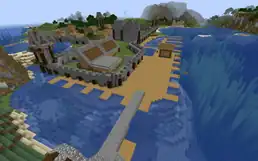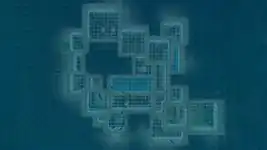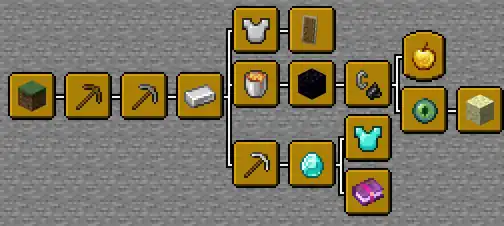Tutorial:Game progression in survival mode

This page provides a basic overview of the game progression in Survival Mode, and assumes that you're playing vanilla survival mode and not using duplication bugs.
This tutorial recommends how to approach survival mode for the first time. Players may deviate from the tutorial as they please to explore or progress at their own pace. You're free to play as you wish, with whichever game rules enabled or disabled, but this tutorial will be tackling the default set of game rules and normal difficulty.
Preamble
Minecraft survival mode is characterized by limited resources that are gathered by the Player. Upon creating a new survival world, the player begins with an empty inventory. The Player must collect resources to protect themself from enemies and food to avoid hunger. They will also want to gather materials for tools needed to collect resources more efficiently as well as progressively better resources previously difficult to obtain.
While progressing through the game is the main focus, there are many other aspects of Survival Mode that the player can choose to partake in; farming, archaeology, building redstone contraptions, etc.
Where do you want to go?
Starting in a new world, resources immediately accessible to the player include wood, dirt, and stone. The player may also encounter surfaced ores such as Coal or Iron. Immediate sources of food come from killing passive mobs like Sheep or Pigs, or farmable plants such as Wheat grown from seeds obtained from destroying Tall Grass.
Caves
Caves offer many of the resources needed to progress in the game, like stone, iron, and diamond- but they are dangerous without proper equipment. Mobs can spawn in the darkness, and lava is frequent, along with structures such as monster rooms and mineshafts additionally spawning mobs. However, with armor for protection, weapons to defend against mobs, and light sources to keep mobs from spawning, caves are more manageable to explore. Strong pickaxes will allow ore to be collected for use.
The Nether
The Nether requires a portal made from Obsidian to access. It is very dangerous compared to the overworld, with oceans of lava across the dimension, and many stronger, hostile mobs. The terrain is less traversable than the overworld because of different, more cavernous world generation. Blaze rods can be obtained, which are used for brewing and crafting eyes of ender, which are required to reach the End. Additionally, mining in the Nether offers netherite scraps, which can be used alongside an upgrade template to upgrade diamond gear to be as powerful as possible.
The End
The End is the last dimension the player will visit. Before defeating the Ender Dragon, it is mostly a platform for fighting it. The player should focus on gathering tools for combat, rather than tools for mining. To defeat the Ender Dragon, the end crystals on top of the obsidian pillars have to be destroyed, and then the player can deal damage to the dragon itself. To accomplish this, bows and arrows, blocks, and potions should be brought to give the player the best chance against it. Returning to the End afterward will let the player visit the outer end islands and end cities- but there's not many natural resources here. Make sure to bring things such as dirt, water, and crops. Living in this dimension can prove to be a tough challenge.
The skies
While the sky doesn't have much to offer, some players will seek out naturally-generated floating islands to build their home on or build a floating island themselves. At the end of the day, it doesn't provide much of an inherent advantage, but you're still free to build a home here if you like.
Explorer or sedentary?
Due to the way in which the game allows us to access resources, due to the size of the world, among other factors, the players could essentially be divided into two categories, the explorers and the sedentary, just as in the real world, human beings were divided long ago between those who settled in groups to exploit a territory and those who dedicated themselves to hunting and gathering at their leisure.
Explorer players are all those who only settle temporarily, live off immediately available resources, constantly advance through their world hunting, obtaining resources from villages, entering temples and ruins just to take out everything that is useful to them and moving forward, these players never settle to establish permanent residences, consequently they do not acquire very advanced production processes related to farms for example, this does not prevent them from getting good materials, weapons and tools, but it does limit the availability of their resources and the abundance of them in relation to those who if they settle, these players usually cover a greater extension of the worlds and can be interdimensional travelers, bone, that their expeditions also extend to the nether, some go on foot, others get a horse, the most advanced are ready to fly around the world with their elytra.
On the other hand, sedentary players are all those who at some point in their game establish a permanent base, on which they undertake all their other activities, usually this is their favorite point of appearance in case of death, on many occasions, it is there same where they build their warehouses, where they establish their crops or their animal pens, in theory, the player can settle in the vast majority of biomes, the player can have different bases and production and operation stations throughout the world, the question is that these must be linked to certain states of permanence, the number of strategies for a player in relation to the way in which he conceives his bases is infinite, but we can highlight some generalities:
Live in fortresses

To defend their properties from external threats, be they players or monsters, many players fortify their grounds in one way or another, usually applying some kind of wall around the land they want to defend.
In the open field
Other players simply leave their buildings exposed, the common thing is to surround everything with a light source to prevent mobs from appearing nearby, otherwise, there is not much else to highlight.
Underground
Some players start and finish their bases under the ground, either in the superficial layers or in the deepest caves, many of their activities are carried out under the ground, this protects them from the vast majority of mobs and players on the surface, in some cases the accesses to the bases are hidden for greater security, but in others they are visible.
In the skies
For some reason certain players take advantage of the game's flimsy gravity and undertake their homes high above sea level, first creating a base pillar or ladder and then creating floating surfaces on which to finish their builds, many of their farms and systems may follow operating even arranged at such a height.
Underwater

Some others specialize in inhabiting bodies of water, whether they are deep lakes, rivers or the ocean itself, the facilities to do so depend on the player's resources and skill, from creating air bubbles underwater to placing catalysts, this strategy isolates them from many mobs but exposes them to many others.
In multiplayer
Everything said above applies perfectly to a survival game in multiplayer mode, as long as said game persists within the guidelines given above, it can be considered within those described in this article.
We can mention one of the great novelties when entering the multiplayer section and it is the insertion of the element of conflict or cooperation between the players.
Many players will remain solitary, but many others will strive to organize themselves in groups, regardless of the number of members and the complexity of the group, it can be said that the latter is the most common behavior, here the product processes are amplified and improved, either because one of the players can implement some more effective method at the service of all, or because as a whole the relationship of consumption and production is inclined towards production, (that is, five players harvesting wheat will produce more even though they consume more wheat in total), the Players in a group will decide the mode of their settlement, and depending on the organization they will be in charge of activities, such as the cultivation of the land, defense, construction, among many others, the important thing is to understand that the usual thing is the construction of small or large societies within the game.
What can happen next depends on a series of factors implicit in the server, from the number of players to the class of players, sometimes large groups form factions and these come into conflict, regarding this the community has done all kinds of conflict exercises, confronting groups, civilizations among a long et cetera.
Players together will be able to progress through the game more easily, from the mines to the End dimension.
Growth outlook in relation to ores
It is natural to relate the level of a player within his world from his tools and personal items, our materials can be made up of two types of material, vegetable and ore, the only useful vegetable material for the tools crafting is the wood, after this comes the ore category, where we find the stone, from here we only find metals and a precious stone, on the armor, the player must discard the first type of material mentioned here (the vegetable) .
Although leather armor exists as a first level, the vast majority tend to jump to metal pieces, moving on to diamond and in many cases ending in netherite, which in theory is the best material available.
Naturally, it is intuited that the level of progression is accompanied by one of these pieces of armor or with their respective material in the tools, which is true to a certain extent, even so, there are better prospects for establishing levels in terms of capacity and progress of the player.
Perspective of growth in relation to the use of mechanics
It can be said that there really is a relationship between the level of the player and the ability to exploit or take advantage of certain game mechanics, this point is especially related to the more technical section of the game, being that the more farms of high cost level and complexity you show, the higher the level of development of your game, let's take it with an example, speaking of obtaining food, many players opt for choosing a particular crop or taking advantage of as many as they can, in short, players usually seek to amplify their food production.
If you have enough stored food to save yourself the time of constantly hunting or getting it, then let's say a player learns how to harvest, they know they need water to keep their crops healthy, but then they learn that the water block hydration reaches four blocks from the point of origin, he learns that villagers can also gather, he learns that water can remove crops without ruining arable land, etc, as he further extends his understanding he can develop new methods (original or borrowed from other players). The player goes from cultivating manually to taking advantage of mechanisms with water currents, then integrates automatic warehouses or villagers to harvest for him, in short, he learns to take advantage of the game's mechanics, consequently the player creates more complex systems but that give higher productivity.
Therefore, we can affirm that to generate an answer we must compare and contrast the differences between different items, thereby recognizing that some bring with them greater technological advance while others are at initial levels.
The progress of a game, of a player or group of players will be greater if they have a greater capacity to protect themselves from death. Along with this, the potential capacity they have to develop even more complex technologies and techniques will also be a great indicator. from what they already materially possess.
Capabilities to evade death
Players, groups of players or games will determine their progression (up to a certain point) in relation to how capable they are in reducing their chances of dying, below we will present a list of aspects that must be mastered, depending on how many have already been covered will be able to better determine the progress of the game, this implies that the more of the following points a player has covered, the higher his level of progress will be:
Mastery over enemies:
This point refers to the fact that your material advantages must prevent you from becoming a victim of other entities, this does not imply that other players or hostile mobs can never kill you, it means that the probability of getting out of any encounter alive must be high Thanks to the material elements that you have acquired, such as enchanted armor, weapons or immortality totems, all those tools that can make your escape easier are also included here.
Abundance:
Another great factor linked to this point is how capable you are to generate resources that keep you alive, in this case the great example is food, although there are relatively simple techniques to obtain a good supply of food, it should also be considered how adequate they are such foods, it is very different to have to hunt constantly to survive to be able to enjoy a good supply of cooked potatoes or golden carrots.
Classification by stages
The following classification method based on the work of Lewis Henry not only gives us some dividing principles to try to accommodate a series of principles to classify a game, it directly gives us a series of labels in which the players and their players can be placed. respective items based on their demonstrable provisions.

The three main states; barbarism, savagery and civilization are subdivided into seven categories:
- Savagery, inferior (related to harvesting).
- Medium (Fishing and language).
- High (Bow and Arrow).
- Barbarism, low (Ceramic).
- Medium (domestication of animals and plants in Europe and irrigation system in America).
- High (related to the possession of weapons and metal tools).
- Civilization, related to the invention of the phonetic alphabet and the use of writing.
All these adapted to the terms of the game would end up being as follows:
- Savagery, lesser (related to gathering, village theft, sporadic hunting, etc).
- Medium (fishing, mastery of stone and wood tools, creation of a settlement).
- High (bow and arrow, mastery of fuels such as coal, minimal early uses of iron).
- Barbarism, low (use of buckets of water, extensively of storage systems).
- Medium (full use of domestic animals and use of crops).
- High (complete command of iron and introduction to diamond, redstone and first steps into the nether).
- Civilization, taking advantage of the most useful enchantments; repair, silk touch, among others, mastery of alchemy.
References
- https://en.wikipedia.org/wiki/Leslie_White
- https://en.wikipedia.org/wiki/Lewis_Henry_Morgan
- https://www.amazon.com/-/Leslie-White-ebook/dp/B00CG68YEA